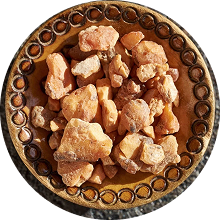Keora Plant (Pandanus odoratissimus)The Kewra plant grows wild along the east coast of India. The plants producing the best floral bouquet are grown in Ganjam district of South Orrisa.It should be noted that Rampe plant (Pandanus amaryllifolius Roxb) is different from Kewra plant. The fragrant leaves of Rampe plant (Pandan Patta) are used to flavor rice and curries.Kewra plant is dioecious, with male and female flowers produced on different plants.
In Sanskrit, the plant is called Ketaki. The male plants are called 'Ketaki Viphala', and the female plants and called 'Swarana Ketaki'.The male plant - flower Only the flowers of the male plant are harvested to extract the floral bouquet to produce Kewra. The flower bouquet is sweet similar to rose flowers, and fruity. The Kewra plant grows up to 18 feet tall. The plants flower three times a year (Summer, Monsoon, and Winter). 60% of the flowers grow during monsoon season (July-September), and posses the best floral bouquet. 30% of the flowers grow during summer (May-June), and remaining 10% grow during winter (October-November).
The creamy white color flowers are encased in long spikes about one foot long. On average, one mature plant can produce about 35 flower spikes.The female plant - flowerThe flower of female plant has no floral bouquet. It is left to develop into fruit.The fruitThe female plant bears a fruit that looks like a pineapple. When ripe, the fruit develops a very mild bouquet.
The fruit is edible.The leaves have no fragrance, they are not edible. The leaves are fibrous and used to weave baskets and mats.The stem and roots have no fragrance and are not edible. The stem and roots are fibrous and used to as a tie for basket and mat making. They are also cut about 8" long pieces, one end is pounded to make it into a coarse brush.
The flavouring derived from a variety of pandan, Pandanus fascicularis. Used in India, it is also called kewda essence and is from the male inflorescence of the plant. It is strongly floral. Use an eye-dropper to add a drop at a time in case too much goes in and ruins the dish. Concentrated oil made from pandanus flowers used to flavor desserts and beverages in Indian cuisine.Widely used in desserts and beverages.
The Keora flower is highly valued for its rich and captivating fragrance, which is one of the most distinctive features of this plant. The Keora flower releases a sweet, floral aroma that is often compared to that of rose, but with its own unique twist. This wonderful scent is captured in Keora Oil, which is extracted from the male flowers. The production of Keora Oil is a delicate process, and it takes hundreds of flowers to yield even a small amount of this precious oil.
Keora Oil is widely used in the perfume industry, especially in traditional Indian attars, where it imparts a luxurious and lasting fragrance. Aside from its use in perfumery, the Keora flower and Keora Oil are also popular in Ayurveda, where Keora Oil is used for its soothing and therapeutic benefits. The aromatic qualities of Keora Oil make it a key ingredient in many cosmetic products, and it is also commonly used to flavor various sweets and beverages, adding an exquisite fragrance to the dishes. The Keora flower is a true symbol of nature’s beauty, and its oil remains one of the most cherished natural scents in the world.
It adds a good aroma, when added to vermicelli Kheer or custards.·Kewra essence, made from kewra flowers, is used for flavouring sweets in sugar syrup, like petha (candied white pumpkin), Ras Malai (cream cheese cooked in double cream). Itr kewra, a stronger concentrate than ruh kewra, is used in dry sweets like barfi (milk toffee) and gajar halwa (grated carrot pudding). Kewra is also used to perfume pulaos. Pan Masala and Gutka are the largest consumer of Indian attars. The reason for using it is its extraordinary tenacity along with characteristic to withstand with tobacco note. Kewra Ruh (Oil) this is 100% pure oil extracted from male Kewra flowers. It takes about 1,000 flowers to produce one ounce of Kewra Ruh. In Ayurveda, the oil is used as a stimulant, and to treat rheumatoid arthritis. Kewra Attar (Perfume) the Kewra flowers are distillated into sandalwood oil. Kewra Attar has about 3% to 5% Kewra oil, and the remainder is Sandalwood oil. Normally, it is specified in terms of number of flower spikes (10,000 to 15,000) per pound of sandalwood oil. This is the most popular perfume used in India. It is applied behind ears, and used to scent clothes. The perfume is also added to various cosmetics. Kewra Jal (Hydrosol)The fragrant hydrosol may be either a primary product from low quality flowers collected during hot summer. It may be a secondary product from Kewra Ruh or Attar production. Kewra Jal is also called Kewra water. Kewra Jal is about 0.02% of Kewra oil. 24 flowers can produce one pound of primary hydrosol.
BMV provides a range of classic Keora products with rich odor like Keora NNO.
Why Choose BMV Fragrances?

Premium Quality:
100% pure and natural essential oils, resinoids, absolutes, and fragrance oils, ensuring unmatched quality.

Innovation-Driven:
Continuous investment in R&D to stay ahead of trends and deliver innovative solutions.

Global Leadership:
Trusted by top brands worldwide for excellence in fragrance production.

Extensive Range:
A wide variety of essential oils, perfume oils and fragrance oils to meet diverse industry needs.

Strict Quality Control:
Every batch undergoes rigorous checks for consistent, high-quality products.

Competitive Pricing:
Top-tier products at competitive prices for great value.

Source directly from manufacturer.
Call Now!Balsamic
Balsamic
Balsamic
Copyright @ 2025 | BMV Fragrances Private Limited | All Rights Reserved
Website Design & Digital Marketing by webmasterindia.
Website Updated On:


